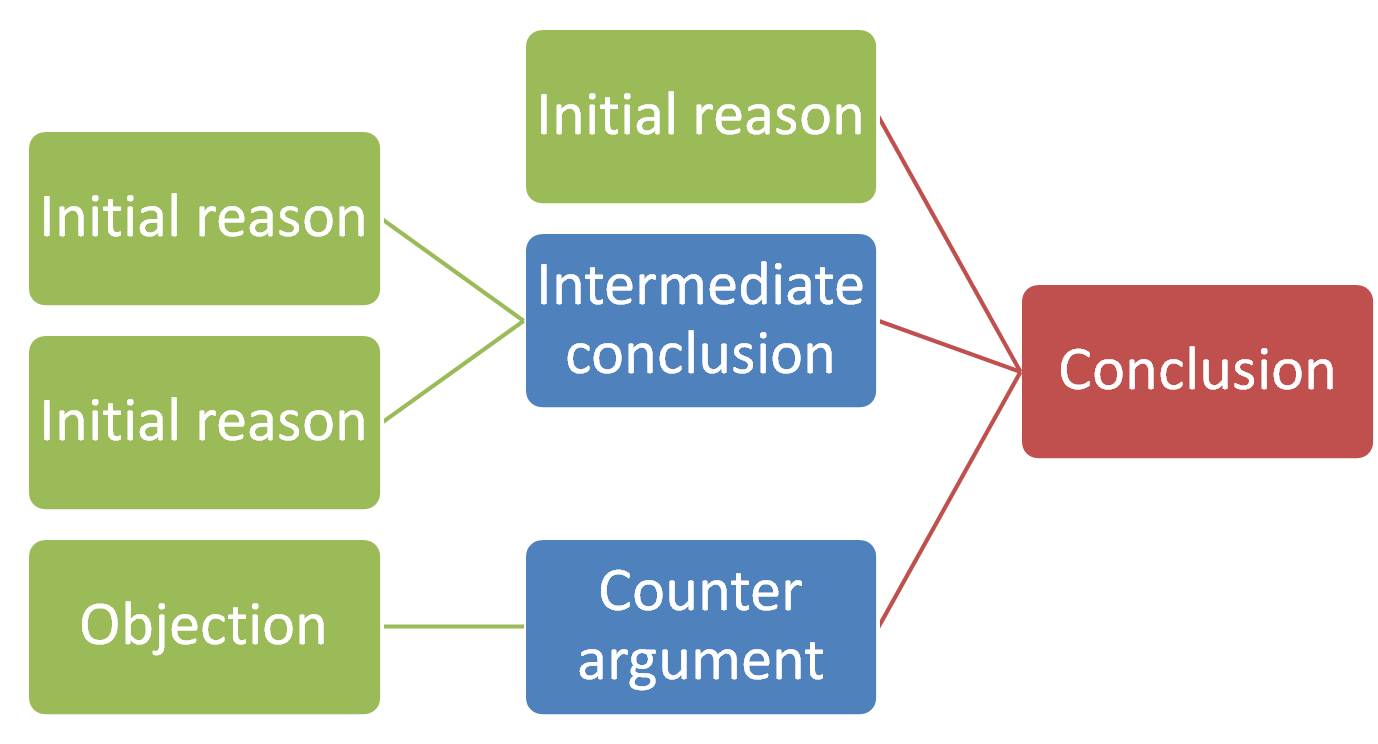A simple argument consists of a conclusion supported by reasons (see Critical Thinking 1). However, most arguments are actually constructions that join these simple blocks of argument together in more complex ways. Just as a novel consists of various parallel sub-plots coming together into the conclusion, so arguments may bring several strands together in a great variety of possible patterns to support an overall claim. If you read a comment column in a newspaper, or an argumentative blog, for example, there will probably be more than one simple argument.
Simple arguments can be joined together in chains in which the conclusion to one argument becomes a reason for the next. The first conclusion us then called an intermediate conclusion. For example, in the following chain argument, the initial reasons are in green, the intermediate conclusion is in blue, and the final conclusion is in red:
Most cats purr when they are stroked.
Purring is a sign of contentment.
So most cats like being stroked.
Felix doesn’t like being stroked.
So Felix is an unusual cat.
Chains can be as long as you want them to be. Having laid out an argument you might also find one of your assumptions being questioned (or anticipate it being so), so you then go back and offer further justifications for your assumption, thus extending the chain backwards.
Arguments can also work in parallel. For example, a list of reasons can be used to support one conclusion, or several chains of argument can all converge on the final conclusion. Complex arguments can also include counter-arguments, where objections are considered and then refuted. The refutation then serves as a reason to support the conclusion.
To make these kinds of arguments clear, diagrams can be very helpful. Austhink have some very useful argument-mapping tutorials if you want to go more deeply into mapping arguments diagrammatically. They sell software for mapping arguments, but it can also be done using Windows SmartArt (examples below) – or, of course, freehand on a piece of paper!
Here’s an example of a ‘list’ style argument with a diagram to illustrate it:
There are all sorts of reasons why hunting with dogs should be banned. Animals hunted with dogs, such as hares and foxes, undergo terrible stress when they are pursued by dogs. It’s impossible to make sure that the animal dies humanely when it’s torn apart by dogs. Fox-hunters argue that numbers of foxes should be controlled, but they can do this by shooting, which is far more humane. They also claim that it is a country tradition that townies could never understand, but merely appealing to tradition does not give justification for a practice.
Exercise
1. Analyse the structure of this argument by stating which sections are the conclusion, intermediate conclusion(s) and initial reason(s). If there are counter-arguments state the objection and the counter-argument.
It is often assumed that world religions all involve different ways of worshipping God or gods, but it can be seen that this is not the case when Buddhism, Daoism and Confucianism are counted as religions. These Eastern religions are not focused on God or gods, and the gods that do appear are incidental to them. Scholars of religion have been overwhelmingly influenced by Christian ideas of what ‘religion’ means, but if you look at a wide range of religious practice around the world it becomes clear that the model of religion as belief in God is just one amongst many.
2. Make up an argument (about anything you like) that follows this structure:

Scholars of religion define religion as God-worship (intermediate conclusion)
Because they are strongly influenced by Christian beliefs (initial reason)
Buddhists, Daoists and Confucians don’t worship Gods (reason)
Buddhism, Daoism and Confucianism are not religions (intermediate conclusion)
But scholars of religion define Buddhism, Daoism and Confucianism as religion (reason)
The scholars’ definition of religion is wrong. (Conclusion)
Migglism, the intriguing title of an important new primer of practical philosophy by a reputable British author, looks set fair to eventually finding its way into the Oxford English Dictionary. (Conclusion)
Despite striking a whimsical and light-hearted note, (Counter-argument) migglism, along with its variants miggling and miggler, has already been adopted as a versatile, meaningful term by students of philosophy, and seems to be gaining ground quickly in everyday conversation, as well as on FaceBook and twitter. (Reason)
‘It’s memorable, distinctive, meaningful, and carries a lot of punch for such a little word’, was the verdict of one student. (Reason) ‘Wriggle, giggle and squiggle probably had to struggle for general acceptance, but look at them now. (Reason) And the fact that miggle rhymes must make it an OED contender; it’s already featured in a poem. (Reason)
Migglism’s author, Robert M Ellis, was rather more circumspect, saying he would watch its progress with interest, and he hoped his book, and its unusual title, would succeed in getting Middle Way Philosophy on the map. (Reason)
I don’t know if this qualifies as an answer, but it’s been a bit of fun
2.
A chilled person is more susceptable to catching germs – green (reason)
Catching a cold is often the result of being out in low temperatures – green (reason)
Medical experts say that this theory is not proven – green (objection)
The head loses most heat if uncovered – green (reason)
The public back up the theory that cold causes illness – blue
(counter argument).
It is unwise to go out in cold weather without wearing suitable clothing – red (conclusion)
I’m still thinking about question 1.
1.
It is often assmumed that World religions….
initial reason, green.
Not the case whenBuddhism….are counted
objection, green
These Eastern religions are not focused…
intermediate, blue
The gods that do appear are incidental….
intermediate conclusion, blue
Scholars are overwhelming…
intermediate, blue ( last three in a chain)
Look at a wide range…
counter argument, blue.
The model of religions as belief in God….
conclusion, red.
Here’s my analysis of 1:
Conclusion: ‘The model of religion as belief in God/gods is just one among many’.
Intermediate conclusion 1: ‘It’s not the case that all religions involve God/gods’.
Intermediate conclusion 2: ‘A wide range of religious practice around the world gives evidence that not all ‘religion’ is like the Christian model’.
Intermediate conclusion 1 is also the counter-argument to the objection: ‘It’s often assumed that world religions all involve some way of worshipping a God or gods’.
It’s further supported by initial reason 1 ‘Buddhism, Daoism and Confucianism are counted as religions’ and initial reason 2 ‘Buddhism, Daoism and Confucianism are not focussed on a God or gods’.
Intermediate conclusion 2 is also the counter-argument to what is implied to be the view of many scholars of religion: ‘Christianity should be the model of what “religion” is.’
Perhaps this one was a bit too challenging!
Both Peter and Norma’s arguments for question 2 had appropriate reasons and conclusions and counter-arguments. However, neither of you made it clear what your intermediate conclusion was!
Hi Robert, for me I think the questions were rather too difficult, I will endeavour to improve though.
I will try to make the exercises a bit easier! I think the next one (#5) is a bit easier.